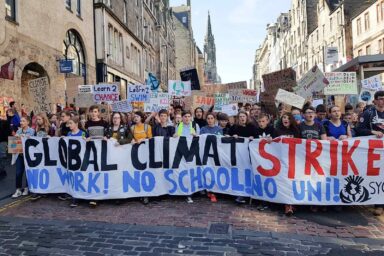Forests Ablaze, Glaciers Melting: Climate Change Threatens US Parks
Whether it’s a mistimed wildflower bloom on Mount Rainier, scorched trees in Yosemite, or a lack of grizzly bears in Yellowstone, climate change is impacting national parks and their visitors.
This story is part of Covering Climate Now, a global journalism collaboration strengthening coverage of the climate story.
In 2020, the number of visitors to America’s 423 national parks fell 28 percent from the previous year, but with President Biden’s pledge to make COVID-19 vaccines widely available by May 1, Americans are likely to be dusting off their suitcases. Those who visit the parks may find a changed landscape.
Patrick Gonzalez, principal climate change scientist of the US National Park Service and associate adjunct professor at the University of California, Berkeley, shared the scenario in a recent interview with WhoWhatWhy: “Human-caused climate change has doubled the area burned by wildfire across the western US, including Yosemite National Park; melted glaciers in Glacier National Park; doubled tree mortality across the western US, including Sequoia National Park; caused a loss of bird species from Death Valley National Park; shifted trees onto tundra in Noatak National Preserve; raised sea level 42 centimeters — nearly up to your knee — near the Statue of Liberty National Monument; and bleached and killed corals in Virgin Islands National Park.”
In a groundbreaking 2018 study, Gonzalez and other researchers reported that US national parks, which cover 4 percent of the US, are experiencing human-caused temperature increases at twice the rate of the rest of the country, causing a vast array of ecosystem disturbances to plants, animals, and the humans living in, working in, and visiting these parks.
The park area is being exposed to more severe heat and aridity than the rest of the country, the study warned, adding that in a worst-case scenario, park temperatures could increase from 3 to 9 degrees Celsius by 2100.
These findings, and those in an updated report Gonzalez published in 2020, are particularly alarming given that the national parks hold some of the country’s last intact refuges for climate-sensitive plant and animal species. “Conservation of intact ecosystems and protection of endangered species rely considerably on national parks around the world because they form the core of the global protected-areas network,” said Gonzalez. Only with significant cuts to human-caused greenhouse gas emissions will temperatures in much of the national park area increase by less than 2 degrees Celsius by 2100, the minimum required by the Paris Agreement, the global climate accord that the US recently rejoined.
WhoWhatWhy focused on four national parks — Montana’s Glacier, Washington’s Mount Rainier, California’s Yosemite, and Montana/Wyoming’s Yellowstone — but all parks will be affected in one way or another. We asked experts and visitors what effects they’d noticed from climate change.

Glacier National Park
Drew Harmon, visitors information assistant at the Medicine Bow-Routt National Forest and recent visitor to Glacier National Park, put it bluntly: “Glacier National Park isn’t going to have glaciers soon, which is terrifying.”
Gonzalez’s report predicted that if emissions continue at their current rate, glaciers could disappear from the park by the 2040s. Sadly, this would be no surprise: Four glaciers in North Cascades National Park had already melted by 2004.
In an interview with WhoWhatWhy, Dawn LaFleur, a park biologist, described some of the ways in which glacial melt and reduced snowpack have affected plant species: “Areas with longer-lasting snow accumulations are disappearing,” she noted. “These areas provide the primary source of soil moisture for alpine plant communities.” As a result, she added, “Many of Glacier National Park’s alpine plants are at the southern limit of their range. It appears that plant species adapted to the highest elevations are the first to decline.”
Glacial melt is also expected to have detrimental effects on Glacier’s mountain goats and ducks. “It is estimated that the park has one of the largest populations of mountain goats in the lower 48 states,” LaFleur said. “However, declining numbers in parts of the Crown of the Continent ecosystem, and pressures from climate change, are causing concern for the health of this species.” According to LaFleur, mountain goats are particularly sensitive to habitat conditions, relying on high, cool, and rocky terrain for their survival. If temperatures continue to increase, she warned, goat populations at the southern end of their native range could cease to exist.
Harlequin ducks, a favorite of birders and Glacier visitors, are especially vulnerable to the threats of glacial melt and early snowmelt. “Nests are usually located within three feet of rushing streams, so any sudden flood can destroy them,” LaFleur said.
Despite the threats, park superintendent Jeff Mow seems confident that Glacier will remain a favorite destination, even without its namesake attraction. “While we cannot speculate on the number of visitors who come specifically to see glaciers,” he told WhoWhatWhy, “we do not believe the loss of glaciers will greatly decrease the number of visitors to Glacier National Park.”

Mount Rainier National Park
Mount Rainier, which towers over the Pacific Northwest at 14,411 feet, is the most heavily glaciated mountain in the Lower 48. According to the National Park Service, warming temperatures are causing the park’s glaciers to melt at six times the historic rate. This rapid melt is sending large amounts of water, rock, and debris down the mountain, causing damaging floods, killing old-growth trees, and destroying roads and historic structures.
Zoe Hutchens, who lives in Portland, OR, and is a frequent visitor to Mount Rainier National Park, has noticed the effects of glacial melt firsthand. “This year, the White River was raging with lots of sediment into late August, which is unusual,” she recalled. “The Wonderland [a 93-mile trail around the mountain] was even being rerouted downriver because the regular crossing was unsafe due to high water levels.”
Another visitor, Venezia DeMaria, remarked on the shrinking ice. “The Emmons glacier on Mount Rainier is a huge example of these rising temperatures in higher elevations,” she told WhoWhatWhy. “And, although it has the largest surface area of any glacier in the contiguous United States, it is receding at an alarming rate that can be noticed easily.”
As ice has decreased, human-caused fires have increased, due to warming temperatures and decades of fire suppression. “The fire danger was much higher in the past year than I have observed in the years prior,” Hutchens said of the 2020 fire season. “Even a small fire really impacted the White River Campground, leaving many trees unstable, and therefore half of the spots in the campground had to be closed due to unsafe trees.” Indeed, the National Park Conservation Association predicted a 200 to 600 percent increase in annual acres burned by wildfires in the western US by 2050, which would not only harm Rainier’s old-growth forests and alpine ecosystems, but could also make areas of the park unsafe to visit.
Perhaps the most iconic feature of Mount Rainier National Park is its meadows of alpine wildflowers, which need winter’s final snowmelt to create the perfect conditions for blooming — typically in summer. However, a study at the University of Washington recently found that early snowmelt is causing the park’s wildflowers to emerge before summer, resulting in what researchers call a “mismatch” between visitors and peak wildflower blooming.
“We know from park surveys that the wildflowers are a major reason people visit Mount Rainier National Park,” said Ian Breckheimer, lead author of the study and a researcher at Rocky Mountain Biological Laboratory and Harvard University. “If visitor peak and flower peaks are at different times, it might affect public support.” Without wildflowers, he concluded, visitors may form less of a personal connection to the landscape, which could make it harder to build support for conservation and climate change legislation.

Yosemite National Park
Yosemite is experiencing significant glacial melt, dwindling snowpack, and warmer spring temperatures. Most notable, however, is the effect climate change is having on the park’s groves of sequoias and forests of cedar, fir, hemlock, oak, and pine. Some of these trees are more than 2,000 years old. The National Park Service reported that the average area burned by wildfires in the park annually from 1984 to 2005 was more than four times higher than it was between 1972 and 1984. The 2013 Rim Fire and 2019 Ferguson Fire killed two people, injured 29, and burned more than 350,000 acres in and around Yosemite.
In his 2020 report, Gonzalez noted, “Across the western US, including sites in Kings Canyon, Lassen Volcanic, Mount Rainier, Rocky Mountain, Sequoia, and Yosemite National Parks, climate change doubled tree mortality from 1955 to 2007, due to drought, the most extensive bark beetle infestations in a century, and increased wildfire.” And fires not only kill trees, whose ability to store carbon is a buffer against climate change; fires release smoke that can exacerbate allergies and lung illnesses.
Yellowstone National Park
America’s first and perhaps most widely known national park is a hotspot for bark beetle infestations. “In Yellowstone National Park and the surrounding ecosystem, bark beetle outbreaks, due to the hotter temperatures of climate change, have caused mortality of half the area of whitebark pine,” Gonzalez wrote in the 2020 report. Higher temperatures have allowed bark beetles to live through winters that would have killed them in earlier years. The ancient whitebark pine species is now restricted to the highest, and therefore coldest, elevations.
Shorter winters and longer summers also disrupt wildlife patterns and migrations like those of the grizzly bears for which Yellowstone is cherished. Before hibernating, grizzlies binge on whitebark pine cone seeds, which are rich in fat, carbohydrates, and protein.
Research by the National Park Service found that when cone production is good, grizzlies use higher elevations, which lowers the risk of human-bear conflict. However, due to extensive bark beetle infestations, bears are increasingly wandering out of the Greater Yellowstone Ecosystem and into human environments in search of high-energy foods. As a result, a 2019 article in Inside Climate News reported: “More bears died in 2018 in the Greater Yellowstone Ecosystem than in any other year in the last four decades, according to the Interagency Grizzly Bear Study Team.” State wildlife agencies euthanized at least 38 bears in 2018 for interacting with humans or their livestock. Grizzlies are listed as threatened under the Endangered Species Act.

What Parks Are Doing
The National Park Service has been increasingly active in responding to human-caused climate change. As far back as 2006, a Park Service memo described responses to climate change as “mostly underdeveloped” and requiring “considerable future planning and implementation.”
In 2016, the agency set an ambitious goal of reducing greenhouse gas emissions from park operations 36 percent from 2008 to 2025, Gonzalez said. “As a result, many national parks improved energy conservation and efficiency, established public transit, installed solar renewable energy, and implemented other sustainability actions. Golden Gate National Recreation Area, the most highly visited park in 2019, reduced its greenhouse gas emissions 25 percent in five years.”
Today, the Park Service’s Climate Change Response Program and Green Parks Plan are designed to address the climate crisis through “science, adaptation, mitigation, and communication.” However, when a reporter with WhoWhatWhy sought answers about how the parks have been affected by climate change and what steps were being taken, a number of park rangers declined to talk.
The Climate Friendly Parks Program, another agency effort, formed a network of parks, including Yosemite and Mount Rainier, to promote sustainability, inform visitors about climate change, track greenhouse gas emissions, and work toward carbon neutrality. Researchers studying greenhouse gas emissions at Mount Rainier found that total emissions generated from park operations decreased by 30 percent from 2006 to 2014.
What You Can Do
The Park Service has four “key messages” about climate change: the process is real and based on scientific data, it transforms the natural and cultural landscapes of parks and affects your adventure, parks are trying to mitigate change by making resources more resilient and reducing their carbon footprint, and visitors can make choices that reduce their own carbon footprint.
One such choice is to take public transit in the many parks that offer it, including Yosemite, Indiana Dunes, Denali in Alaska, and Zion in Utah. “Transportation generates more carbon pollution than any other sector in the US,” Gonzalez pointed out, and small actions can make a big difference. Taking the Bay Area Rapid Transit train into the Golden Gate National Recreation Area, for example, can cut a visitor’s carbon pollution by 88 percent compared with driving a car, according to Gonzalez.
The Park Service also notes that the future of the national parks is largely dependent on the decisions Americans make outside the parks on a daily basis. The agency recommends modifying lifestyle choices, participating in community action, contacting policymakers, and mitigating the impacts of climate change at home. Useful tools include the US Environmental Protection Agency’s household carbon footprint calculator, which provides an estimate of household greenhouse gas emissions resulting from energy use and waste disposal, and several other carbon footprint calculators.
Related front page panorama photo credit: Design by Aman Dembe / WhoWhatWhy from Ben Soyka / Unsplash, Bryan Ramos / Unsplash




